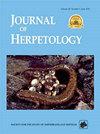Cannibalism in Microlophus Lizards
IF 0.8
4区 生物学
Q3 ZOOLOGY
引用次数: 0
Abstract
Abstract. Cannibalism involves killing and consuming an individual of the same species. Different factors modulate cannibalism, and here we explored whether the diet diversity would mediate the cannibalism propensity in Microlophus lizards. We compiled the available information on diet and cannibalism of the 22 Microlophus species. We found that there is a relatively high incidence of cannibalism within Microlophus, as 41% of the species exhibited this behavior. There are, however, few reports of cannibalism by each species. Cannibalism propensity showed a positive association with diet diversity, which suggests that a generalist diet might provide room for cannibalism in Microlophus lizards. We also found that only adults, mostly males, consume juveniles. Conspecific predation pressure may explain the habitat segregation among age classes reported in some Microlophus species that exhibit cannibalism. Finally, cannibalism appears to be an ancestral condition in Microlophus, as it occurs in the two main clades of this genus. Moreover, Tropidurus, the sister taxon of Microlophus, also includes species that exhibit cannibalism, and the ancestor of these genera may have exhibited cannibalism.小型蜥蜴的食人行为
摘要食人包括杀死并吃掉同一物种的个体。不同的因素调节同类相食,在这里我们探讨了饮食多样性是否会介导小嘴蜥蜴的同类相食倾向。我们汇编了关于22种小腹蛛的饮食和同类相残的现有信息。我们发现,在Microlophus中,同类相食的发生率相对较高,41%的物种表现出这种行为。然而,很少有关于每个物种都吃人的报道。食人倾向与饮食多样性呈正相关,这表明多面手饮食可能为Microlophus蜥蜴的食人行为提供空间。我们还发现,只有成年人,大多数是男性,才会食用青少年。同种捕食压力可能解释了在一些表现出同类相残的小腹蛛物种中报告的年龄级之间的栖息地分离。最后,自相残杀似乎是小龙属的一种祖先状况,因为它发生在该属的两个主要分支中。此外,Tropidurus,Microlophus的姐妹分类单元,也包括表现出食人行为的物种,这些属的祖先可能表现出了食人行为。
本文章由计算机程序翻译,如有差异,请以英文原文为准。
求助全文
约1分钟内获得全文
求助全文
来源期刊

Journal of Herpetology
生物-动物学
CiteScore
1.60
自引率
0.00%
发文量
45
审稿时长
6 months
期刊介绍:
The Journal of Herpetology accepts manuscripts on all aspects on the biology of amphibians and reptiles including their behavior, conservation, ecology, morphology, physiology, and systematics, as well as herpetological education. We encourage authors to submit manuscripts that are data-driven and rigorous tests of hypotheses, or provide thorough descriptions of novel taxa (living or fossil). Topics may address theoretical issues in a thoughtful, quantitative way. Reviews and policy papers that provide new insight on the herpetological sciences are also welcome, but they must be more than simple literature reviews. These papers must have a central focus that propose a new argument for understanding a concept or a new approach for answering a question or solving a problem. Focus sections that combine papers on related topics are normally determined by the Editors. Publication in the Long-Term Perspectives section is by invitation only. Papers on captive breeding, new techniques or sampling methods, anecdotal or isolated natural history observations, geographic range extensions, and essays should be submitted to our sister journal, Herpetological Review.
 求助内容:
求助内容: 应助结果提醒方式:
应助结果提醒方式:


